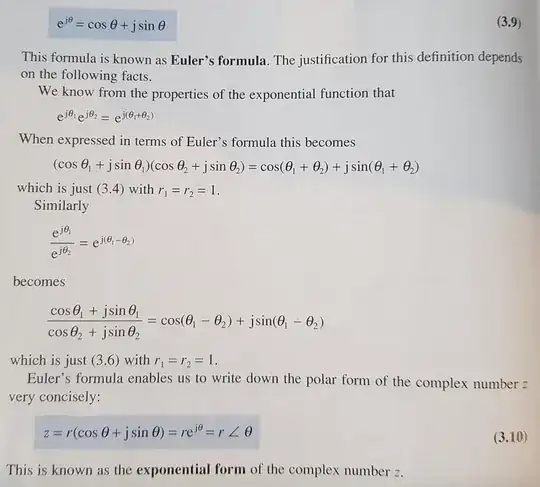I am looking at this proof (in the image) from a textbook for engineering mathematics:
I don't understand this proof, and my reasoning is as follows:
Known True Statements:
$z=r(cos\theta + isin\theta)$
$z_1z_2 = r_1r_2[cos(\theta_1 + \theta_2) + isin(\theta_1 + \theta_2)]$
$\frac{z_1}{z_2} = \frac{r_1}{r_2}[cos(\theta_1 - \theta_2) + isin(\theta_1 - \theta_2)]$
$e^{i\theta_1}e^{i\theta_2} = e^{i(\theta_1+\theta_2)}$
The line in the proof saying "When expressed in terms of Euler's formula, this becomes..." seems to me to be equivalent to:
IF $e^{i\theta} = cos\theta + isin\theta$, then
$e^{i\theta_1}e^{i\theta_1} = (cos\theta_1+isin\theta_1)(cos\theta_2+isin\theta_2)$
$e^{i\theta_1}e^{i\theta_1} = cos(\theta_1+\theta_2) + isin(\theta_1+\theta_2) = z_1z_2,$ where $r_1=r_2=1$
and:
$\frac{z_1}{z_2} = cos(\theta_1-\theta_2) + isin(\theta_1-\theta_2) = \frac{z_1}{z_2},$ where $r_1=r_2=1$
Therefore if Euler's formula is true, then it can be shown that $z = re^{i\theta}$, and since $z=r(cos\theta + isin\theta)$, it is finally shown that $e^{i\theta} = cos\theta + isin\theta$
I don't understand this proof because at the step when the proof says "When expressed in terms of Euler's formula this becomes...", I interpret this as meaning we assume the statement to be true. Am I correct in this assumption?
If that assumption is correct, is the proof circular because it assumes the statement is true in order to prove the statement?
Thanks very much!
